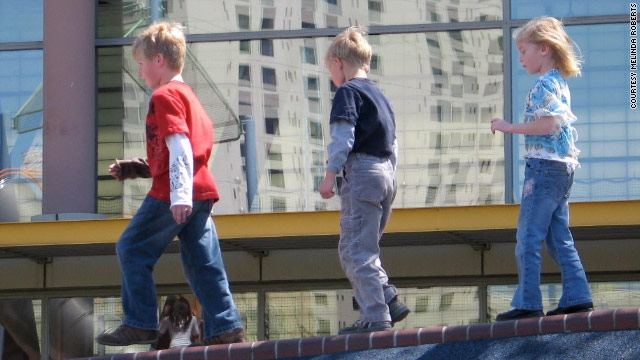Ghosts, monsters, dragons: What to tell kids

- Study suggests preschoolers want to be told the monster under the bed is nice
- Others say it's always better to tell them "it's not real"
- Thinking about the process of making a film can help children cope with scary images
- It's OK for parents to turn off the television if the program or movie is too scary
(CNN) -- When Melinda Roberts is watching animated movies with her kids -- 7, 9, and 11 -- she'll help them recognize voice actors and talk about the creation process so they won't get scared.
"They can get into the story, but feel a little bit safer about it because they know who the actor is," said Roberts of San Jose, California.
A new study in the journal Child Development suggests that reassuring kids by telling them scary images aren't real is helpful for those around 7 and up, but for the younger ones it may not be preferred. Researchers at the University of California, Davis, found that when preschoolers get scared, they prefer to think of the fantastical threat as "nice."
Children ages 4, 5, and 7 were asked questions about stories involving a protagonist of the same gender encountering real and imaginary creatures such as bears, snakes and dragons. They found that the girls tended to suggest that the protagonist avoid the creatures, while boys wanted to attack them.
The study's recommendation that may seem counterintuitive to parents is that even though 4-year-olds recognize the difference between fantasy and reality, they would rather be comforted by a positive pretense than by the notion that "it's not real."
In other words, if a child believes there's a boogie monster under the bed, parents should say that it's friendly or "wants to play" in the heat of the moment, rather than dismissing the fear by saying it's all in the child's head, they said. Later, when he or she has calmed down, parents can explain that the monster was not real, the study authors say.
Dawn Huebner, a psychologist in Exeter, New Hampshire, and author of "What to Do When You Worry Too Much: A Kid's Guide to Overcoming Anxiety," disagrees. If children are old enough to understand the difference between fantasy and reality, they should learn to cope with the idea that the image that haunts them is not real.
Parents can teach their children how to differentiate fears in their heads from actual danger, she said. Concepts such as "false alarms" can help kids understand that the fear they feel does not mean there is an actual threat, and that they can reassure themselves.
"It's helpful for parents to talk about the elements that make it not real," Huebner said.
But the study authors, psychologists Liat Sayfan and Kristin Hansen Lagattuta, say they've each used the "it's a nice monster" strategy with their own children when they were younger, and it worked.
"It's not suppressing the negative thoughts. It's sort of staying in it and reframing it a little bit more positively," Lagattuta said.
Still, it's unclear how much any kind of verbal coping will help, said Joanne Cantor, professor at the University of Wisconsin, Madison. She recommends distracting the child and allowing him or her to hug a stuffed animal or sit in a parent's lap.
It may be that they are able to deal with the notion of a "friendly ghost" before they can cope with the "it's not real" explanation, but previous research has shown that 3- and 4-year-olds can't use reasoning to make themselves feel better, she said.
The new study was small, with 48 participants, and the authors are already engaged in a follow-up to see how children react to the coping strategies they identified.
The study authors and Huebner agree that it's OK for parents to turn off the television if the program or movie on the screen is too scary for young audiences.
Jamie Reeves of Nashville, Tennessee, who runs the Blonde Mom Blog, is also closely monitoring her daughters' (4 and 7) TV content.
"Explain to them that if they are scared of something, they might not understand what something is, they can always talk to you about it," Reeves said.
Still, says Huebner, it's better for a child not to leave the room or cover his or her eyes when watching a scary character, because that little glimpse can leave a more lasting impression than prolonged exposure, Huebner said.
For example, some children get scared even when they see the cover of a DVD, she said. Rather than walking away, parents should show the image to the child and talk about how it was created.
Thinking about the process of making a film can help children cope with scary images, experts say.
Kids are fascinated by the details of special effects -- for example, how fake blood is released from a bag at the same time that a gunshot is heard, said Roberts, who has run The Mommy Blog since 2002.
Jennifer James of Winston Salem, North Carolina, founder of the Mom Bloggers Club, agrees. Her daughters, now 8 and 11, were around age 5 or 6 when they started questioning what was real and what wasn't.
James said she made a conscious effort to shield her kids from scary content in books, TV and movies, and can't even name anything that made them particularly afraid.
Roberts, though, remembers two months ago when her 7-year-old daughter, Daphne, came in the room near the end of the violent drama "Kill Bill" and insisted on watching. As it turned out, Daphne was fine with the sword fighting, but freaked out at the portrayal of a spot of blood in snow. Her mother turned off the movie after that scene.
"Even when you think you can take a chance, you can't be sure what's going to flip them out," Roberts said.
